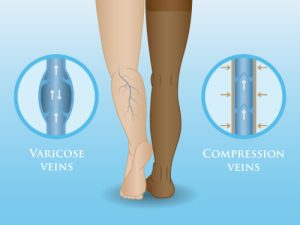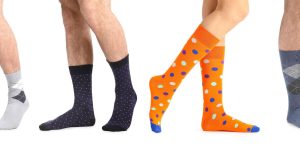If you’ve ever shopped for compression socks, you’ve probably seen the unit measurement mmHg on the label or in the product description. We’re used to seeing the world around us measured – whether it’s hours in the workday or teaspoons in a recipe, but mmHg is often a new one for most first-time compression sock users. So what does it mean?
mmHg stands for millimeters of mercury, and it measures pressure or compression. Compression socks with a higher mmHg will apply more pressure or compression to your legs, making them feel tighter and more supportive.
The most common type of compression sock has graduated pressure, with higher compression around the ankle, and decreasing pressure as the sock goes higher up the leg. This means you’ll often see a range on your compression socks, like 15-20 mmHg.
Which range is right for you? Read on to find out.
Light to Mild Compression – 8-20mmHg
Anything under 20 mmHg is considered non-medical, meaning you don’t need to get a prescription. Compression stockings in this range are generally worn for comfort and/or improved circulation, and can be purchased in a wide range of styles.
8-15 mmHg: Socks with this range provide minimal compression. They’re a great choice for people new to compression socks. They can help with tired, achy legs or minor swelling, and offer light support.
15-20 mmHg: This range is often recommended for people wanting to prevent DVT, or blood clots, during long travel on a car or airplane. They provide the same benefits of the 8-15 mmHg range, but provide more support. Starting around this range, the size of your socks really matters, so make sure you buy the right one for you.
Compression socks below 20 mmHg are a great choice for:
- People whose professions require them to sit or stand for long periods of time, like nurses, flight attendants, truck drivers, and many desk jobs
- Those that may be taking long trips on a plane or in a car
- Pregnant people who experience swelling in their legs, feet, and ankles
- People with tired, achy, or swollen legs that want to feel more comfortable
- Athletes wanting to improve circulation and recover more quickly after an event
Medium Compression – 20-30mmHg
Compression socks over 20mmHg are considered medical grade – meaning their use is most often needed to help treat an existing condition rather than simply for comfort. While you’ll typically want to seek out a prescription and a professional fitting for these, you may still be able to find them without needing a doctor’s note. You may also see compression socks that bridge the gap between these ranges, e.g. 15-25 that do not require a prescription.
20-30 mmHg – Socks in this range are often a good fit for those who experience swelling in their ankles or feet by the end of the day, and a lower compression level was ineffective. They can provide relief for mild to moderate edema from pregnancy, for aching and fatigued legs, and may help with varicose veins.

Before purchasing socks in this range, it’s best practice to check in with your doctor to make sure socks in this range are right for your needs. You’ll also want to pay attention close attention to sizing to get the right fit.
Firm to Extra Firm Compression – 30-50mmHg
If you feel you need compression stockings in this range, consult with your doctor to make sure you’re getting the right level and fit. You’ll need a prescription and a professional fitting.
30-40 mmHg: Socks in this range can provide some relief from severe varicose veins and swelling.
40-50 mmHg: These should only be worn under a physician’s supervision.
Compression socks in this range are used to help treat medical conditions and should be used under the supervision of a doctor.
——-
If you are experiencing swelling or pain in your legs, it’s important to discuss these issues with your doctor to determine the underlying cause and best course of treatment. Compression socks are a great tool when used as part of a complete treatment plan.
Boring compression socks are a thing of the past – we have a wide variety of stylish options to keep your feet and your fashion both at the top of their game. Need help finding the right compression socks for you? Check out our selection here!


 Top 20 Medical TV Shows – Ranked
Top 20 Medical TV Shows – Ranked